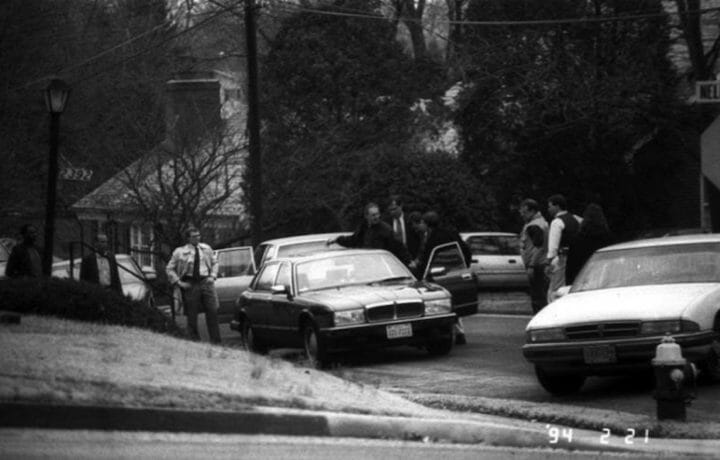It was 27 years ago today, April 28, 1994, that Aldrich “Rick” Ames pleaded guilty to his nine years of espionage on behalf of the Russian Federation/Soviet Union. Ames, at the time of his arrest on February 21 of that same year, had served over 31 years within the CIA’s Directorate of Operations, much of it with a focus on Russian and Eastern European operations.
I knew Ames within the context of work. He sat in the office of the CIA’s Soviet European division’s counterintelligence shop which reviewed of all operational cases involving the targeting and recruiting of Russians. It was from within this office he drew his information when he began his treacherous acts of espionage against the United States in April 1985. My interaction with him began after I finished my multiple tours in the Soviet Union (1981-1986) from the late-1980s into the early 1990s.
Throughout this time period, when I traveled back from abroad to visit CIA headquarters for consultations, Ames always seemed to have time. He was, in hindsight, doing the job the Soviet’s were paying him handsomely to do, attempting to identify all activities of the CIA targeting Russian diplomats and intelligence officers abroad.
Ames espionage begins 1985
While Ames began his nine years of espionage in 1985, the information he compromised spanned decades of work conducted by the CIA vis-a-vis the Soviet Union. It is safe to say, that Ames by his own admission identified to his KGB and subsequently to the SVR the identities of every CIA targeted or recruited Soviet Union/Russian official which he became aware.
In 1985, damage to the U.S. intelligence ability to acquire intelligence from sources inside the Soviet Union began to deteriorate and deteriorate rapidly. It is important to remember, that multiple U.S. sources existed within the KGB’s operational stable, the two most referenced are Hanssen and Howard, who had or were able to provide some of the same information being provided by Ames.
Edward Lee Howard
Howard was a junior case officer in the pipeline for Moscow Station who was dismissed for cause (petty theft) on the eve of his departure in 1983. Howard did not take his abrupt dismissal well and beginning in 1984 he began making phone calls into the U.S. embassy from his home in New Mexico asking to speak to the senior-most foreign service national within the Embassy to discuss the “CIA in Moscow.” Howard would defect to Moscow in September 1985 after Soviet counterintelligence officer Vitaly Yurchenko identified Howard (and others) as possible Soviet agents, following Yurchenko’s defection in August 1985. The irony, Ames was part of the Yurchenko debrief team and thus he was able to tipoff the Soviet intelligence (KGB) concerning Howard and others. Initial damage assessments put the finger of compromise firmly on the forehead of Howard, yet his knowledge wasn’t sufficient to explain the totality of the compromises occurring.
Robert Hanssen
Hanssen, a veteran counterintelligence officer from within the FBI, had been spying for the Soviet Union, for years prior to Ames initiating his actions. We now know, based on the perfect vision of hindsight, that both he and Ames had compromised those cases which the FBI and CIA ran jointly and to which initial compromise of those assets was initially attributed to Ames (and Howard).
Arrest of Ames – February 1994
The CIA formed a taskforce to identify the cause of the compromise the U.S. assets in the Soviet Union, the task force over the course of a number of years finally whittled down their list of possible sources to one Rick Ames. The clues were numerous starting with spending beyond his means, though he claimed the new found wealth was the result of his Columbian wife’s inheritance, the funds were actual part of the close to $2 million the Russians gave him for his espionage activities.
The Washington Post in April 1994 tells us then Assistant U.S. Attorney, Mark J. Hulkover, said at the time of Ame’s guilty plea, “These are crimes which caused people to die as surely as if the defendant pulled the trigger.” And they died, he added, “because Rick Ames wasn’t making enough money for the CIA and wanted to live in a half-million-dollar house and drive a Jaguar. Well, Rick Ames bought the house, he bought the Jaguar, and he acquired the other trappings of wealth that he couldn’t acquire on a government salary, but at some point Rick Ames has to pay the price.”
The efforts of this taskforce are detailed in the book “Circle of Treason” and the mini-series “The Assets”, written by the participants, my former colleagues, Jean Vertefeuille and Sandy Grimes. The damage to the mission of the CIA while not insurmountable, was considerable.
Ames, now 79, is known as prisoner 40087-083 and is serving a life sentence at the medium security federal correctional institution in Terre Haute, IN. Those he compromised weren’t so fortunate; they lost their lives.
———
For additional reading, November 1994 SSCI 141-page pdf: “Assessment of the Aldrich H. Ames espionage case and its implications for U.S. intelligence”




